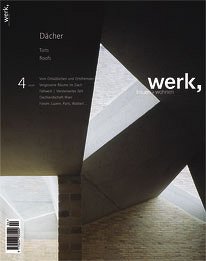Editorial
Editorial
What is a house without a roof? Yet not every building is a house. Martin Heidegger says that etymologically „Haus“ (house) contains the notion of the „Hut“ (hat), and indeed it is primarily the roof that expresses the function of the house as a protective, sheltering place. This perhaps explains why we often experience roofs as symbols of identity that can arouse strong emotions, as indeed happened in the battle waged by Modernism against the (pitched) roof. The space immediately beneath a roof is always a very special one. In some cases it remains concealed and mysterious, often it is stuffed with objects banished from everyday life. But at times it is left open and is the most important space in the house, its presence signalised and shaped by the roof. This is true of most tents and of many halls, but is also valid elsewhere. In attic conversions both of these aspects often play a role. Once you ascend above the eaves cornice level of a city, you enter another, very special world. Here you can feel liberated from the earth-bound banalities of everyday life and yet find well-sheltered and sheltering spaces. Part of the nature of a roof (whether it be flat or pitched) is that it rests above something. It both protects and indicates the existence of what lies below it, sometimes in an open and inviting way, at other times in rather distant manner, or in a restrained, neutral fashion. This is why the roof is so intimately linked with the notion of a house, whereas it tends to contradict the understanding of a building as a body. A body is a single entity, that is to say it is essentially solid or enveloped and therefore does not have a distinct facade or roof. This sounds plausible yet it is precisely the roof that gives many buildings their arresting corporeality. For Steen Eiler Rasmussen, for example, roofs are often a vital aspect of those sculpturally formed buildings that, under the keyword „Klump“ (clod or lump), he describes as characteristic of what he terms „Nordic architecture“. And indeed the works of K. Fisker or P.V. Jensen-Klint (as well as many traditional houses) prove that to be strongly expressive a building does not have to be a „monolith“; a house with a roof can, very definitely, also have this quality. Moreover – and this too should be considered in outlining a theory of body versus roof - the striving for an „all-over“ solution that is evident in much recent architecture and is essentially hostile to the roof has, especially in the „monoliths“ and „blobs“, often produced extraordinarily exciting spaces that are, so to speak, roof spaces without a roof and that have made a significant contribution to the revival of interest in this theme. And here is where we encounter something of a paradox: while in the awareness of the general public the flat roof is becoming established as the standard form, architects are now beginning to reinvestigate the possibilities of the pitched roof. The editor
